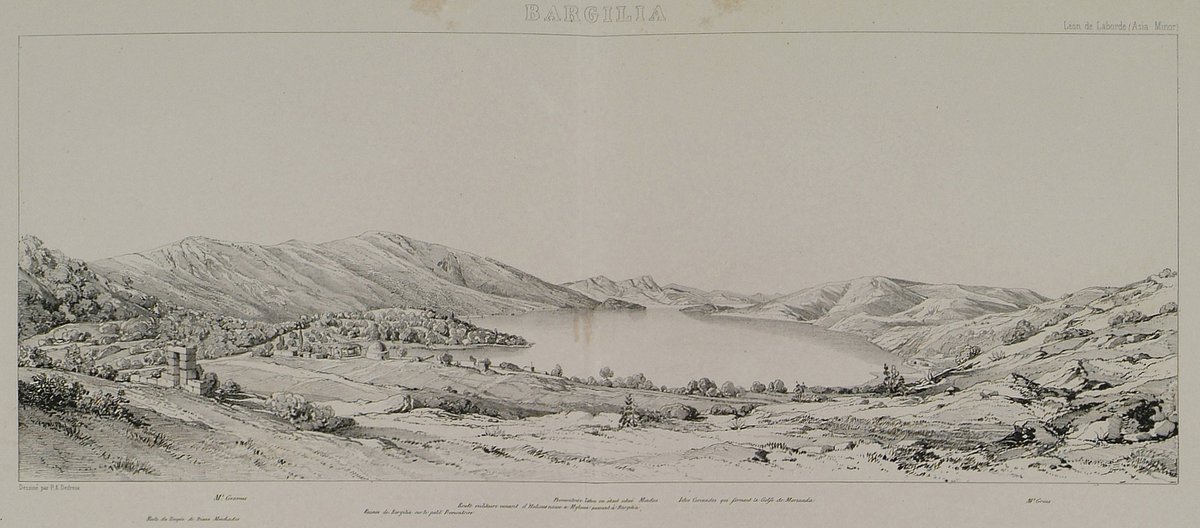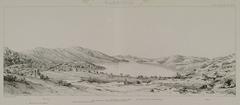
Bargylia Visiting Hours, Tickets, and Historical Sites in Milas, Turkey
Date: 14/06/2025
Introduction
Bargylia, an evocative ancient Carian city, lies nestled along the southwestern coast of Turkey in Muğla Province, close to the modern village of Boğaziçi and near the city of Milas. Steeped in myth and history, this archaeological site stands apart from more commercialized destinations, offering a tranquil and immersive journey through millennia—from the late Bronze Age to the Byzantine era. According to legend, the city was founded by Bellerophon in honor of his companion Bargylos, whose demise at the hooves of Pegasus is immortalized in the region’s mythology and coinage (UNESCO; Wikipedia).
Bargylia once thrived as a maritime hub, its prosperity reflected in the remnants of temples, theaters, harbors, and city walls set amidst olive groves and coastal vistas. Today, it offers a serene alternative to busier sites, welcoming visitors with open access and an authentic sense of discovery. This comprehensive guide details Bargylia’s history, archaeological highlights, practical visitor information, and insights into the rich local culture of the Milas region.
Contents
- Introduction to Bargylia
- Historical Background
- Early Foundations and Carian Era
- Hellenistic and Roman Prosperity
- Late Antiquity and Byzantine Transition
- Archaeological Features
- Visitor Information
- Visiting Hours and Tickets
- Accessibility and Facilities
- Getting There
- Nearby Attractions
- Cultural and Local Experiences
- Fishing Village Life
- Cuisine and Crafts
- Birdwatching and Nature
- Festivals and Community Events
- Practical Tips for Visitors
- Frequently Asked Questions (FAQ)
- Visuals and Media
- Summary Table: Visitor Essentials
- Sources
Historical Background of Bargylia
Early Foundations and Carian Era
Strategically located on the Gulf of Güllük, Bargylia’s natural harbor was central to its emergence as a trading center. Archaeological evidence points to continuous habitation from the late Bronze Age onward. The city’s founding myth—Bellerophon’s commemoration of Bargylos—permeates local lore and ancient coins, emphasizing its mythological significance (UNESCO).
During the Carian period, Bargylia became part of a network with other coastal cities like Halicarnassus and Iasos. The city’s acropolis, necropolis, and harbor installations illustrate a blend of Carian and Hellenistic influences.
Hellenistic and Roman Prosperity
Following Alexander the Great’s conquest, Bargylia flourished under Hellenistic rule. Grand structures such as the Temple of Artemis Kindyas and a semi-circular theater were constructed, reflecting both Carian traditions and Greek religious syncretism (UNESCO).
Under Roman rule, Bargylia enjoyed stability and urban expansion, including the addition of a bouleuterion, agora, baths, and an extensive necropolis. The harbor was pivotal for exporting agricultural products, fish, and purple dye, linking Bargylia to regional trade networks. The city’s coinage, featuring Artemis Kindyas and Pegasus, underlines its civic pride and economic vitality (Ancient Coins).
Late Antiquity and Byzantine Transition
Gradual decline set in during late antiquity, influenced by earthquakes, harbor silting, and shifting trade routes. Yet, Bargylia persisted into the Byzantine period, with Christian basilicas added and pagan structures repurposed. The city was eventually abandoned in the early medieval era (UNESCO).
Archaeological Features of Bargylia
- Theater: Hellenistic in origin, seating around 2,500, it served as a cultural focal point.
- Temple of Artemis Kindyas: The site’s most renowned sanctuary, associated with unique meteorological legends and regional religious traditions.
- Necropolis: Rock-cut tombs and sarcophagi provide insight into burial practices and social hierarchy.
- Harbor Installations: Remnants of ancient quays and breakwaters highlight Bargylia’s maritime role.
- City Walls and Gates: Defensive structures from the Hellenistic and Roman periods remain visible.
- Agora and Other Public Buildings: While less excavated than sites like Euromos, Bargylia’s ruins offer an authentic archaeological experience (Mugla Guide; Tripomatic).
Visitor Information
Visiting Hours and Tickets
- Hours: Bargylia is an open site with no official entry times; visitors may explore at any time. For safety, daytime visits (8:00 AM–6:00 PM) are advised.
- Tickets: Entry is free; there is no ticket office or staff on site. No advance booking is required (Tripomatic).
- Guided Tours: No permanent guides on site, but local guides from Milas or Boğaziçi may be arranged for a richer experience.
Accessibility and Facilities
- Terrain: The ground is uneven and overgrown, with loose stones and mild slopes; sturdy footwear is essential.
- Facilities: No restrooms, shops, or shaded areas are available at the site; the nearest amenities are in Boğaziçi village.
- Mobility: The site is not wheelchair accessible and may be challenging for those with limited mobility.
Getting There
- By Car: The most convenient option; Bargylia is about 20 km from Milas, 40 km from Bodrum. Follow signs for Boğaziçi.
- Public Transport: Limited; minibuses (dolmuş) run from Milas to Boğaziçi, but schedules may vary.
- Parking: No designated lot; roadside parking is available near the entrance.
Nearby Attractions
- Boğaziçi Village: Charming fishing village with seafood restaurants and basic accommodation (Turkish Travel Blog).
- Milas: Offers a range of services, markets, and historical sites (World City Muğla).
- Euromos and Iasos: Notable archaeological sites within easy driving distance.
Cultural and Local Experiences
Fishing Village Life
The adjacent Boğaziçi village sustains a centuries-old fishing tradition. Observing daily routines—boats returning at dawn, nets being mended—offers a glimpse into the region’s enduring culture (Turkish Travel Blog).
Cuisine and Crafts
Fresh seafood, Milas olives, and traditional Turkish meze highlight the local cuisine. The area is famed for its olive oil, with markets offering artisanal varieties (World City Muğla). The handwoven Milas carpets and woodwork of Çomakdağ exemplify local craftsmanship.
Birdwatching and Nature
Lake Tuzla, adjacent to Bargylia, is a protected reserve and birdwatching hotspot—especially for flamingos and herons in winter (Wikipedia).
Festivals and Community Events
Annual festivals celebrate local food, crafts, and the olive harvest, providing immersive experiences for visitors (World City Muğla).
Practical Tips for Visitors
- What to Bring: Water, sun protection, sturdy shoes, snacks, camera, guidebook or offline maps, and cash (cards rarely accepted locally).
- Best Time to Visit: Spring and autumn for mild weather and wildflowers; early mornings or late afternoons in summer.
- Safety: No on-site staff or emergency services; exercise caution and avoid visiting alone.
- Etiquette: Dress modestly, especially in rural or religious areas; respect ruins and natural surroundings, and carry out all trash (Living Nomads).
- Photography: Permitted for personal use; drone use requires permits.
Frequently Asked Questions (FAQ)
Q: What are Bargylia’s visiting hours?
A: The site is open at all hours, but daytime visits are strongly recommended for safety.
Q: Is there an entrance fee?
A: No, admission is free; there is no ticket office or staff.
Q: How do I get to Bargylia?
A: Best reached by car from Milas or Bodrum; limited minibuses run to Boğaziçi.
Q: Are guided tours available?
A: Not on site, but local guides can be hired in Milas or Boğaziçi.
Q: Is Bargylia suitable for visitors with limited mobility?
A: The terrain is uneven and not wheelchair accessible.
Q: Can I use a drone?
A: Drone use is discouraged without a permit; check local regulations.
Visuals and Media
Enhance your visit by exploring online virtual tours, interactive maps, and high-resolution images of Bargylia’s theater, temple ruins, and coastal landscapes. These resources are available via local tourism sites and visitor centers.
Summary Table: Bargylia Visitor Essentials
| Aspect | Details |
|---|---|
| Location | Near Boğaziçi, Milas, Muğla Province, Turkey |
| Access | Car recommended; limited public transport |
| Visiting Hours | Open 24/7; recommended daylight visits |
| Admission | Free, no tickets required |
| Facilities | None on site; basic amenities in Boğaziçi |
| Terrain | Uneven, overgrown, not wheelchair accessible |
| Best Time | Spring or autumn; early/late hours in summer |
| What to Bring | Water, sun protection, sturdy shoes, camera, guidebook |
| Nearby Services | Restaurants, cafes, small hotels in Boğaziçi, Milas |
| Etiquette | Modest dress, respect ruins, basic Turkish is helpful |
| Safety | No staff on site; take precautions |
Explore More and Stay Connected
Sources
- Visiting Bargylia: History, Tickets, and Travel Tips for Muğla’s Ancient Carian City, 2025, UNESCO (UNESCO)
- Exploring Bargylia: Visiting Hours, Tickets, and Historical Sites in Muğla, 2025, Ancient Coins (Ancient Coins)
- Bargylia Visiting Hours, Tickets & Travel Guide to Muğla’s Ancient Coastal Ruins, 2025, Tripomatic (Tripomatic)
- Cultural Insights and Local Experiences, 2025, Turkish Travel Blog (Turkish Travel Blog)
- G Turkiye - Ancient City of Bargylia, 2025 (G Turkiye)
- Living Nomads - What to Know Before Visiting Turkey, 2022 (Living Nomads)
- World City Muğla - Milas, 2025 (World City Muğla)
- Wikipedia - Bargylia, 2025 (Wikipedia)
Plan your visit to Bargylia and immerse yourself in the echoes of ancient Caria—where history, myth, and nature converge on the tranquil shores of the Aegean.
